 Technology peripherals
Technology peripherals
 AI
AI
 Application of event-aware clustering gain network in creative ranking of Fliggy Insurance
Application of event-aware clustering gain network in creative ranking of Fliggy Insurance
Application of event-aware clustering gain network in creative ranking of Fliggy Insurance

1. Background introduction
When it comes to creativity, everyone will first think of advertising creativity. In fact, insurance creativity is recommended It is also a vertical application product for advertising creativity.

The problem solved by computational advertising is to serve specific users under specific semantics Select the appropriate ad to match the best creative graphics. In the auxiliary insurance recommendation module, the context refers to some contextual information about the user purchasing air tickets or train tickets; in the search scenario, the context refers to some query words in the search engine; user-related information refers to the user's base Information, such as age and gender, etc.; advertisements are insurance products, hotel cosmetics and other products of magnitude N; the number of creative graphics and texts is of magnitude N*M. The challenges facing computational advertising lie in large-scale optimization and search problems under complex constraints.
This article mainly talks about the recommendation of creative pictures and texts. The selection and ordering of advertisements will not be considered. Next, we will introduce how Fliggy Insurance uses creative recommendations. of.
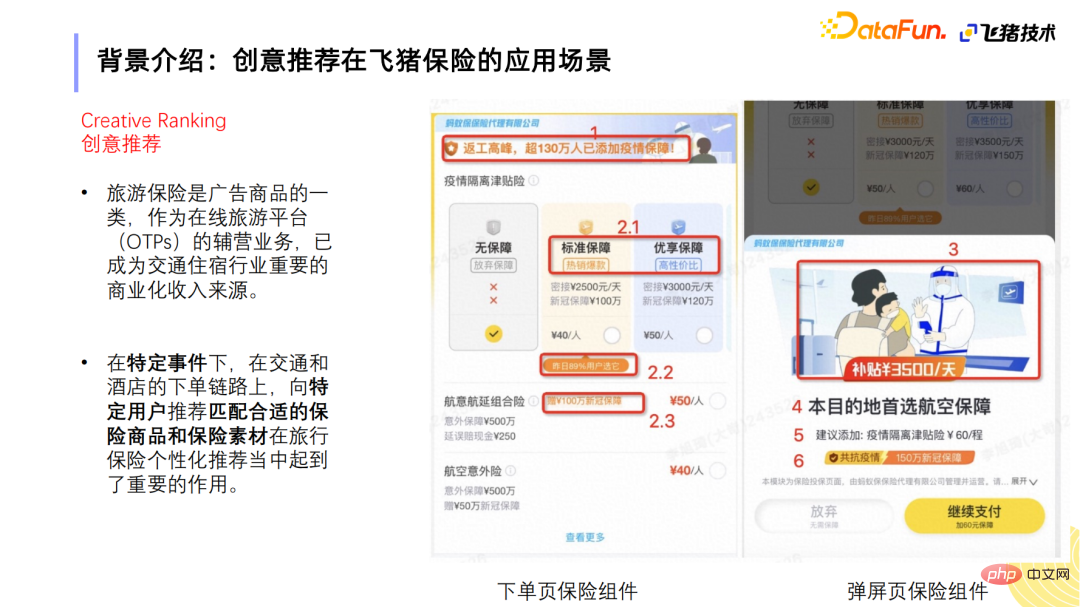
First of all, in the OTP industry, travel insurance as an auxiliary business is now a relatively important source of commercial income. . In insurance recommendations, in addition to product recommendations and price recommendations, creative recommendations have been used as a very important personalized recommendation module. For example, when filling in personal information, you can see some components, and when you pull down the checkout, you will also see pop-up windows.
2. Challenges in Creative Recommendation of Insurance

Creative Recommendation of Insurance The challenges faced can be summarized into three major categories:
The first category is data sparseness, including sparse user data and sparse creative data. Creative data sparseness refers to the fact that operations or UI students iterate creative ideas, or some creative ideas are put on and off shelves due to seasonal reasons, so the creative exposure online is not evenly distributed. In addition, since travel, insurance and creativity are low-frequency transactions, we rarely get three pieces of related purchase data, such as the user's personal purchase history data. At the same time, because insurance is an auxiliary product, unlike search, you can clearly know the user's purchasing intention. There is also a lack of a unified and structured system between creative understanding and user understanding.
The second category is sample data counterfactual. Each user can only see unique creative copy, that is, they can only see creative A or B. Multiple creative ideas cannot be exposed to the same user at the same time period and point in time.
The third category is Cross-industry creative cold start. Fliggy Insurance spans multiple industries. When starting to intervene in new industries, how to reuse knowledge in existing fields, such as migrating some ideas that work well in industry A to industry B, is also a problem we will solve later. .
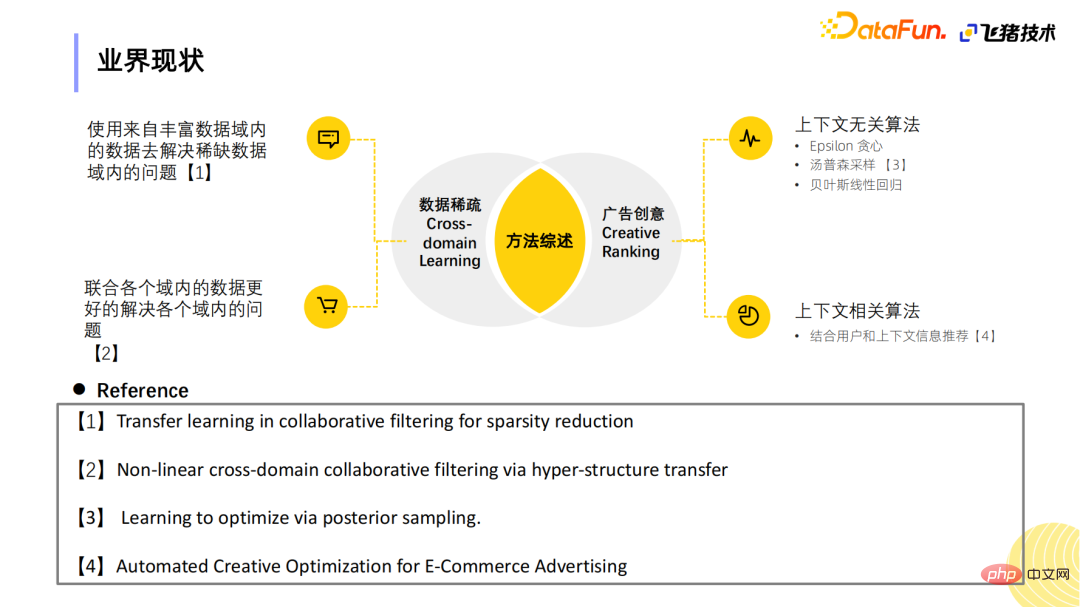
Let me briefly introduce the current situation of the industry.
Advertising creativity is divided into two broad categories of algorithms: one is context-independent algorithms, such as Epsilon greedy, or Thompson sampling, and some more elegant E&E algorithms made by Alimama students, such as Bayesian linear Regression-related; the other type is context-related algorithms, which add user and contextual information as recommendations.
To solve the problem of data sparseness, Cross-domain learning is mainly used to solve two problems, two related tasks, using data in rich data domains to solve problems in scarce data domains, and combining data in multiple domains to Solve problems in various domains.
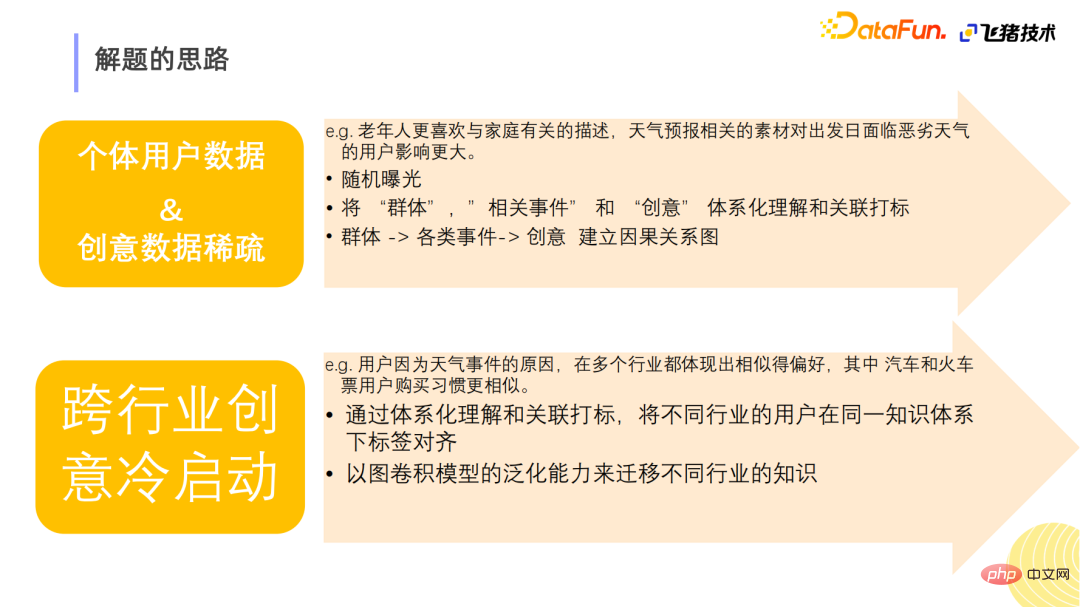
In order to solve the three challenges, our team put forward some solution ideas:
First of all, start with From the data insights, we can see that our data on the creative historical preferences of individual users is relatively sparse, but we can actually make some characterizations of group users. For example, it can be seen from the data that the elderly prefer descriptions related to family; when there is bad weather on the departure day, the air ticket industry is more sensitive to materials similar to weather forecasts. Then we can transform our thinking from individual user data to how to unify the understanding of groups, related events and creativity, and make group recommendations after association marking. After systematic understanding, establishing a causal relationship diagram among the three can solve some of the problems of sparse individual user data.
To address the problem of sparse creative data, our solution is to randomly expose new materials online when they come online.
Another problem is the cold start of cross-industry creativity. For example, we found that regarding weather event factors, no matter in various industries, everyone’s preferences are actually relatively similar, especially in the bus ticket or train ticket business, everyone’s purchasing habits are very similar, so some creative recommended knowledge is Migration can be carried out through the labeling and systematic understanding and label association just mentioned. By aligning labels of different industries under the same knowledge system, some generalization transfer of knowledge is performed through the generalization ability of the graph convolution model.
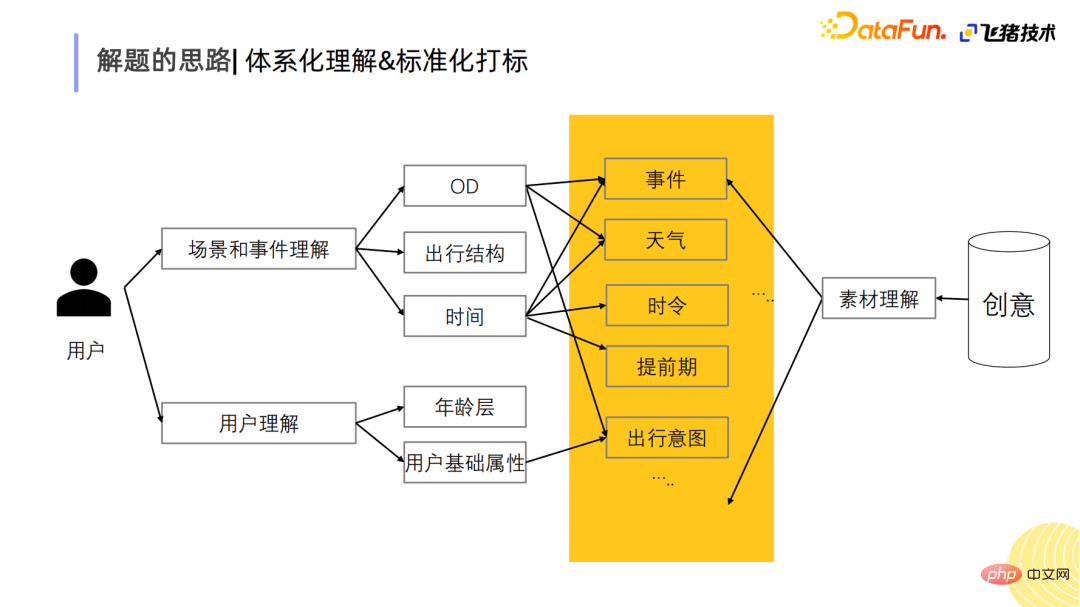
##The systematic understanding and standardized marking just mentioned are mainly divided into three parts:
One part is on the user side, where we will do some understanding of scenarios and events; the other part is on the user’s basic attributes; and finally, on the creative side, we will do some understanding Understand some graphic and text materials. Finally, all three are unified and standardized under the label system, which will help to establish the relationship between graphs later.
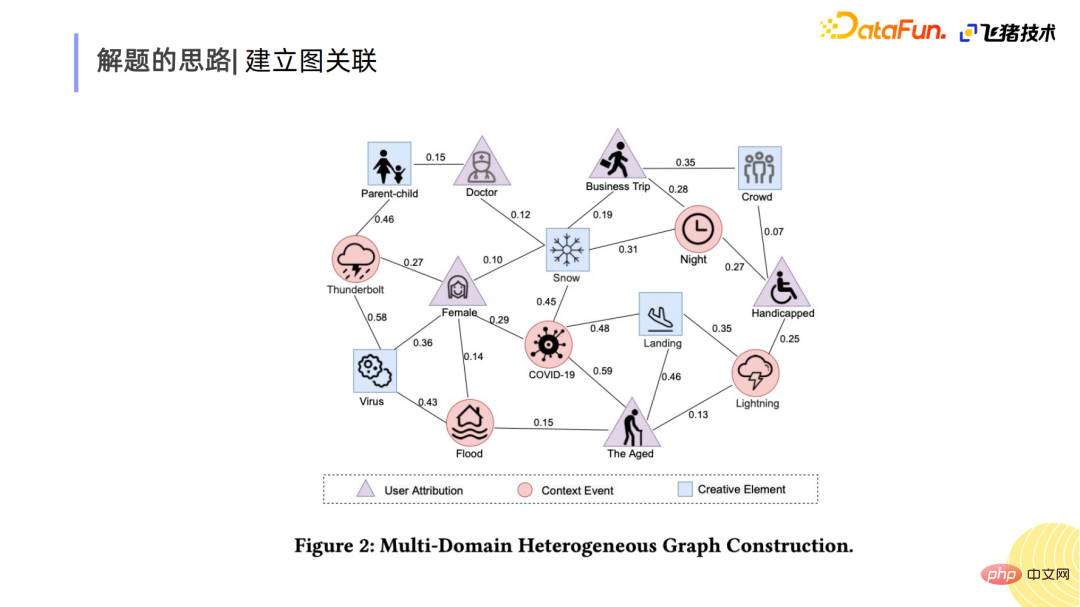
The picture above is a more obvious picture. Among them, the triangle symbols are some attributes on the user side, such as women or old people; the circle symbols are to classify events or context understanding, such as thunder or traveling at night; and the square symbols are the classification of materials.
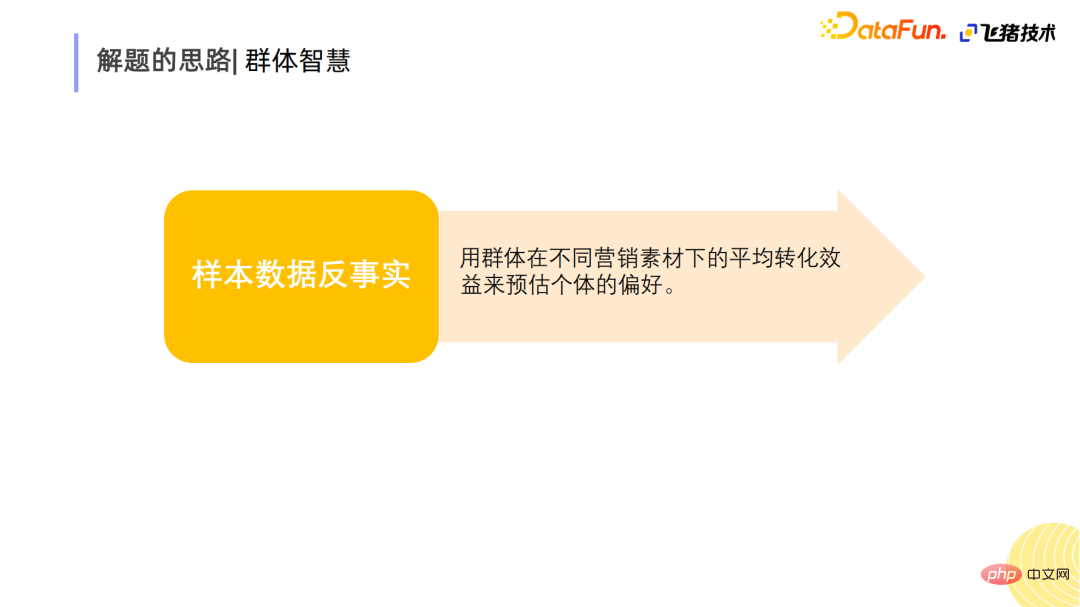
3. Solution
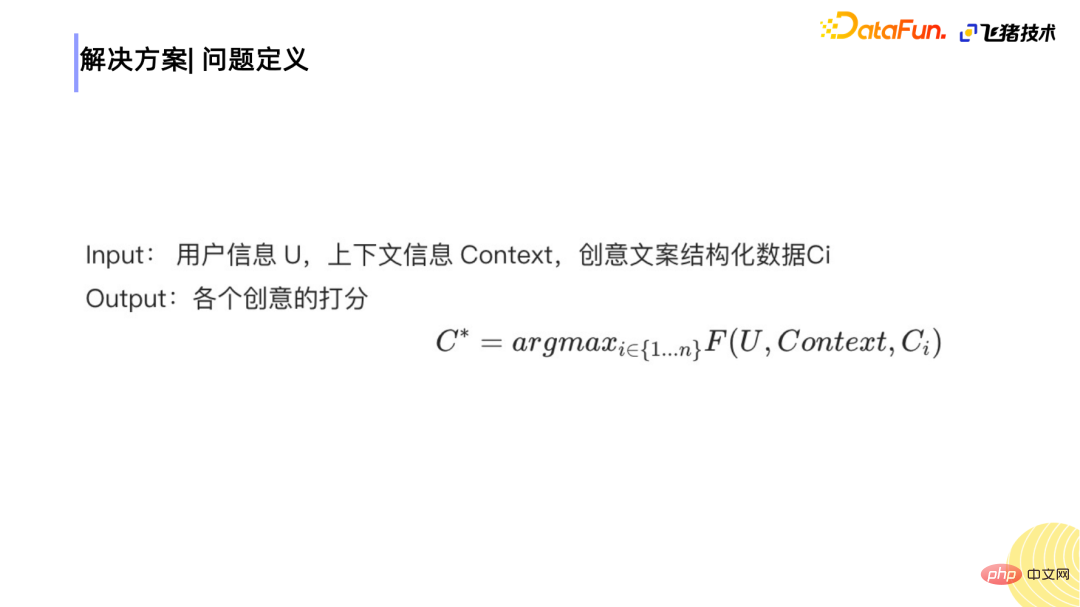
##Combining the solutions of the three types of ideas just mentioned, we A model design of the network structure is proposed. First define the problem: the input is user information, contextual information and structured information of creative copywriting, to sort and score advertising creatives, and then select the creative with the highest score to output to the user. #The picture above is the framework of the creative graphic and text recommendation process for insurance. #First of all, as mentioned above, in the creative module, we do not interfere with the sorting of insurance types or prices. The sorting of creative pictures and texts is As the final ordering logic for the link. When a user request comes in, four understandings are done. Event-level understanding, such as whether it is raining now; scene understanding, such as whether the user is multiple people with children or an elderly person; and understanding of the user's basic attributes. After the material library is also marked with the tags just mentioned, the label recall of the materials and the subsequent sorting of material creativity will be carried out. On the sorting side, a part of the traffic will be allocated for uniform online exposure. The other part is to do the work of creative optimization. The creative selection work is divided into two steps: One is to recall and rough sort the image materials, the other is to rough sort the copywriting materials, and finally Cartesian combination is used to display the creative copywriting we want. , and finally prioritize it through ECUNet. Based on the three solution ideas just mentioned, the design ECUNet solution. It is mainly divided into three parts: The first part is based on event-aware graph vector extraction, mainly on the offline side. The training process is to extract graph vectors for each user-side information, contextual information or creative information; the second part is the adaptive clustering gain network. The problem solved in this part is to use the uplift idea to utilize the group. Intelligently solve individual problems; the third part is to use the characteristics of the three parts of users and scenes, user events and creativity, and use the comprehensive vectors obtained through graph vector extraction to do Co-Attention between the two, with the purpose of extracting the mutual relationship between them. characteristics, and finally do the scoring. The construction of heterogeneous graphs is mainly divided into two parts : Part of it is node construction, and part of it is edge construction. Node construction is mainly when user samples come in and can be mapped to three types of nodes: user nodes, event nodes and creative nodes. After mapping to three types of nodes, edges can be constructed between nodes. The edge represents the importance of the insurance transformation of node a due to reason b. For example, the weight of student node a in bad weather node b will be higher than the weight of student node a in normal weather node. 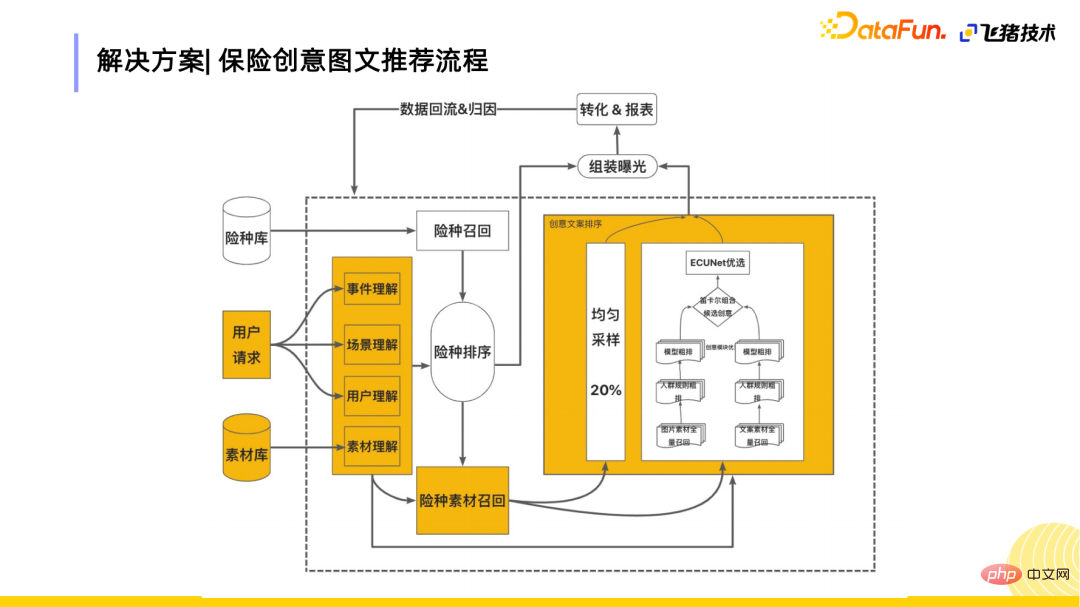
1. Overall structure ECUNet

2. EAGT: Constructing heterogeneous graphs

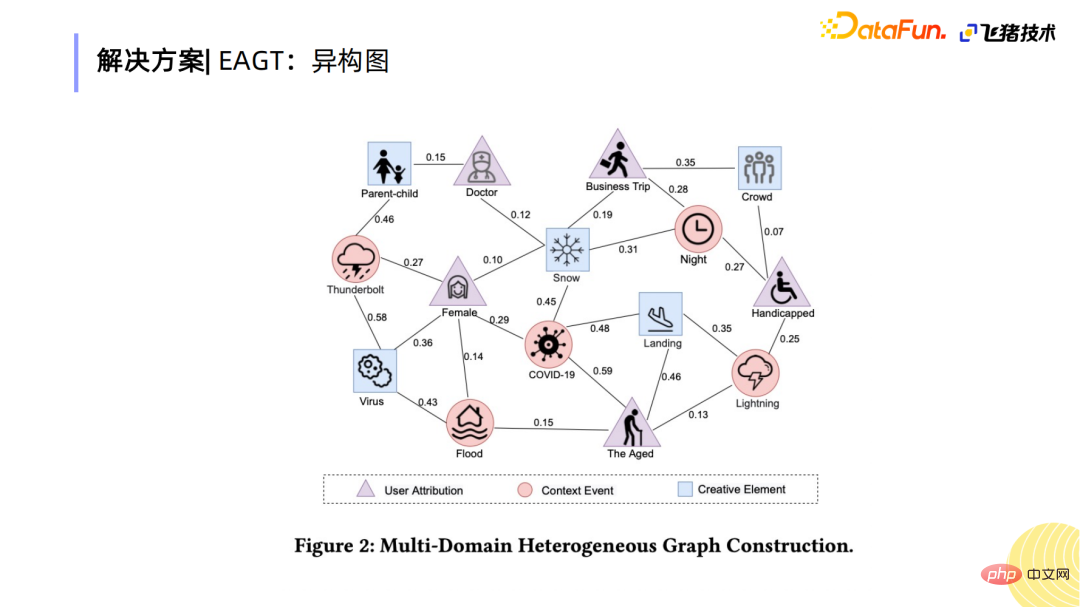
Based on the above method, a heterogeneous graph was constructed. Based on this graph, the node representation of the three scenes of each node is extracted by comparing conventional Node embedding.
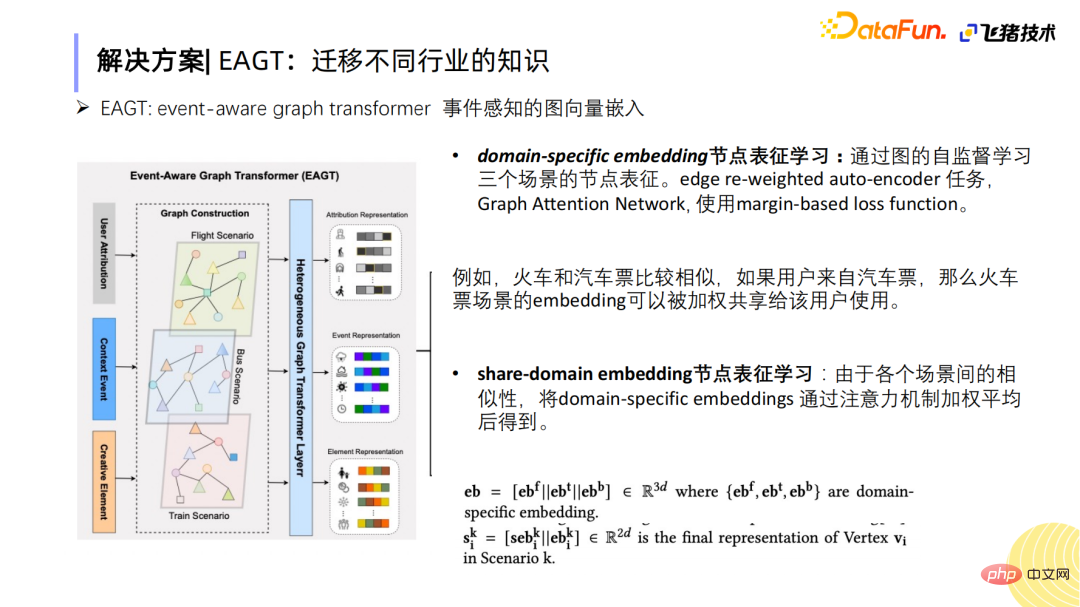
is mainly the task of edge prediction through self-supervised learning of graphs, and loss uses margin -based loss function, what is finally learned is the node representation of specific scenes, such as the three scenes of machine/fire/steam.
But in order to transfer knowledge from different industries and integrate it into other scene industries, we did share-domain embedding node representation learning. For example, train tickets and bus tickets are similar. If a user sample now comes from bus tickets, the embedding of the train ticket scene can also be weighted and shared for users to use. Based on this assumption, share-domain representation learning was performed. It mainly represents the nodes of three types of scenes and obtains specific embedding through the weighting of the attention mechanism.
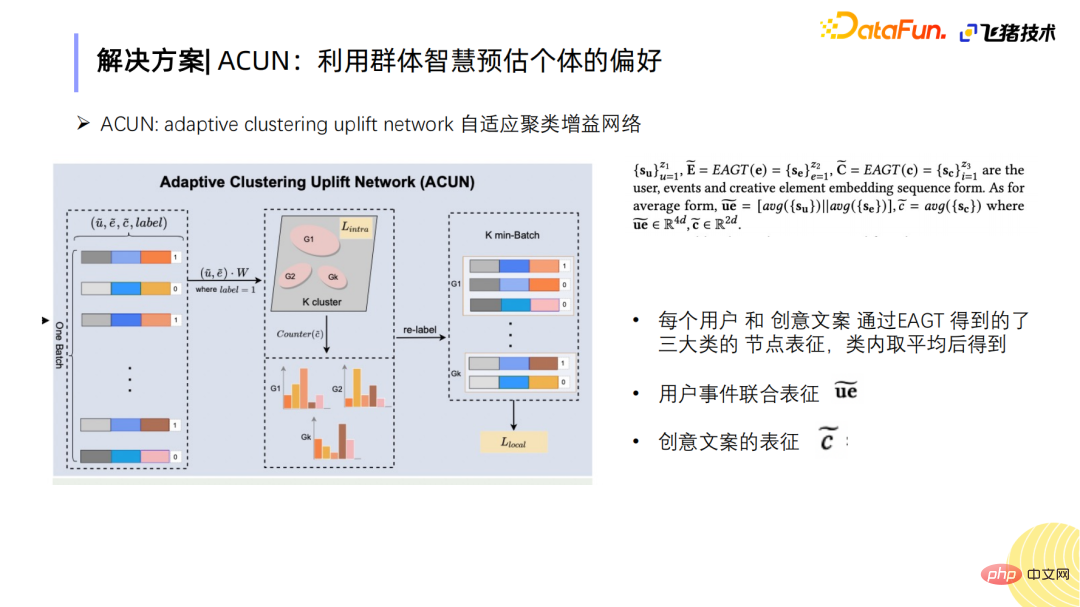
Through this EAGT Network we can extract three major categories of node representations. After each sample can obtain the node representations of three major categories, the average value within the category can be obtained to obtain the three node representations of users, events, and creative ideas. Finally, the joint representation of user events and the joint representation of each creative copy are input into Part 2 - Adaptive clustering gain network.
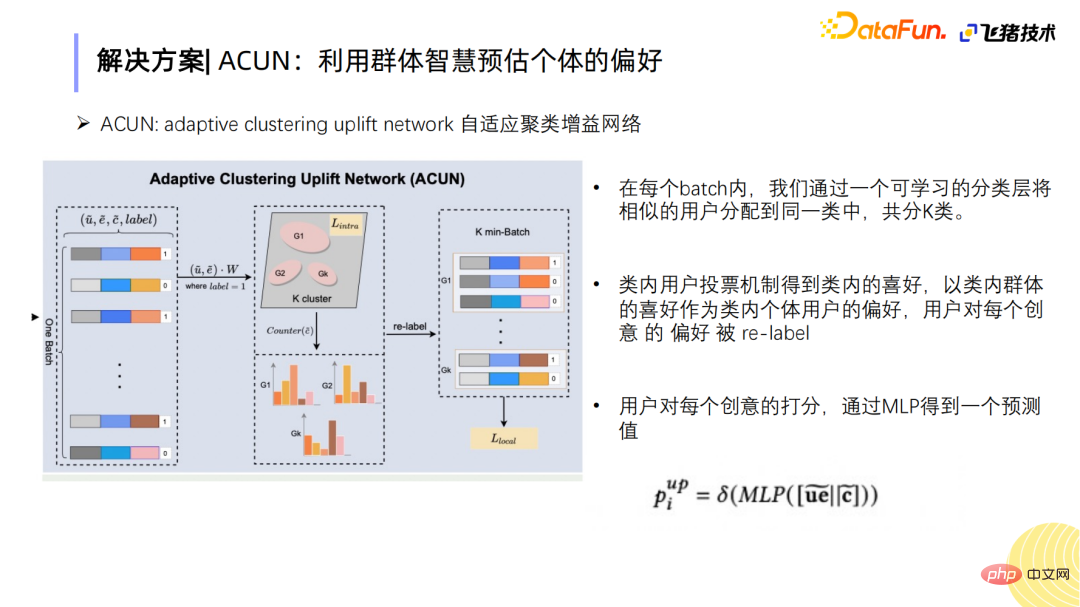
Use the wisdom of the crowd to estimate individual preferences, process It is performed based on operations within the batch. In each batch, users in each batch are classified into k major categories through a learnable classifier, hoping that similar users can be classified into the same category. Under the guarantee of the random sample sampling mechanism, users in the inner category can vote on similar creative copywriting to get which creative copywriting the inner category users are more interested in. Finally, the preferences of the in-group are used to represent the preferences of individual users, and then each sample is re-lable. For example, G1 is more sensitive to the third creative idea, and G2 is more sensitive to the second one. Users in the inner category will re-lable it again. After obtaining the re-lable sample, perform MLP prediction to obtain the predicted value.
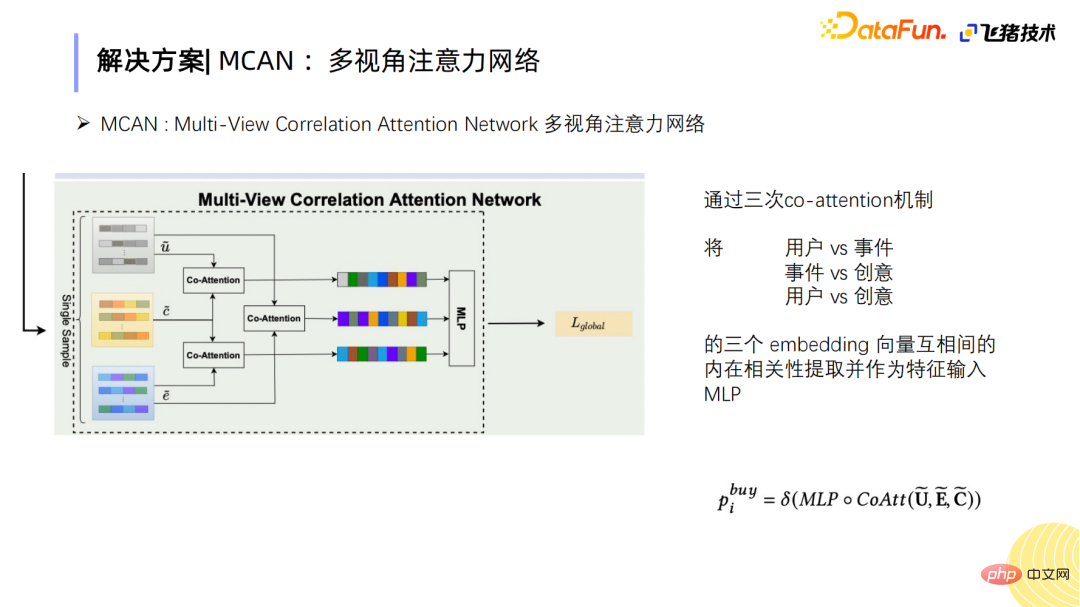
##Multi-perspective attention network, the main purpose is Through the three-dimensional Co-attention mechanism, the intrinsic related interests between users and events, events and ideas, and users and ideas can be extracted as important features for prediction.

4. Experiments and Analysis
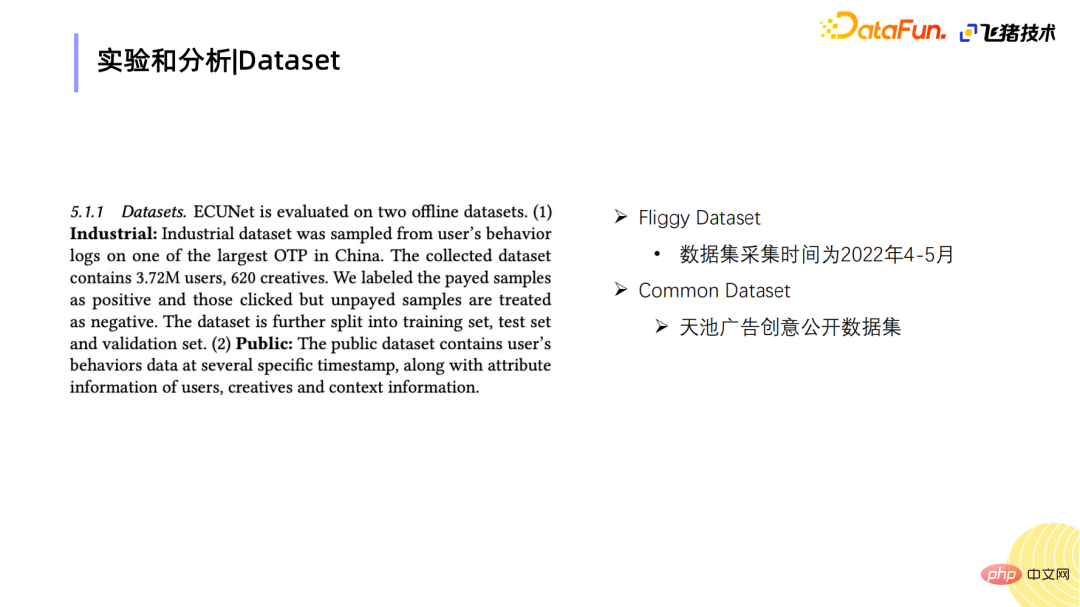
Part of our Dataset is from the industry, collected from Yu Feizhu’s Dataset. The other part is the public data set of Tianchi Advertising Creative.
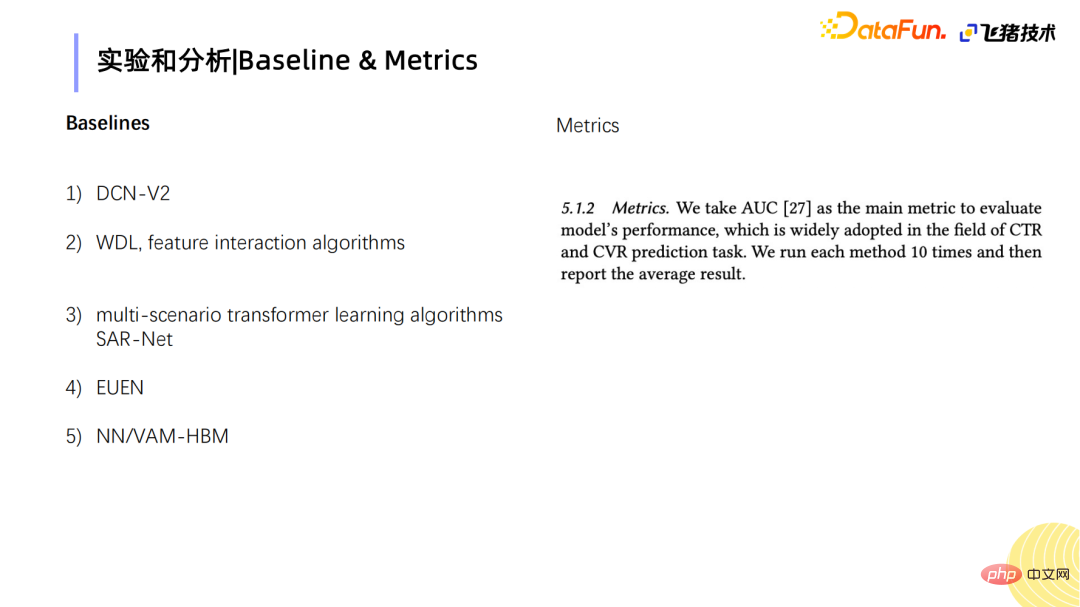
We also studied the ranking algorithm of advertising creatives in the industry, as well as some baselines on user interests and cross-scenario learning. For comparison, Metrics are mainly AUC.
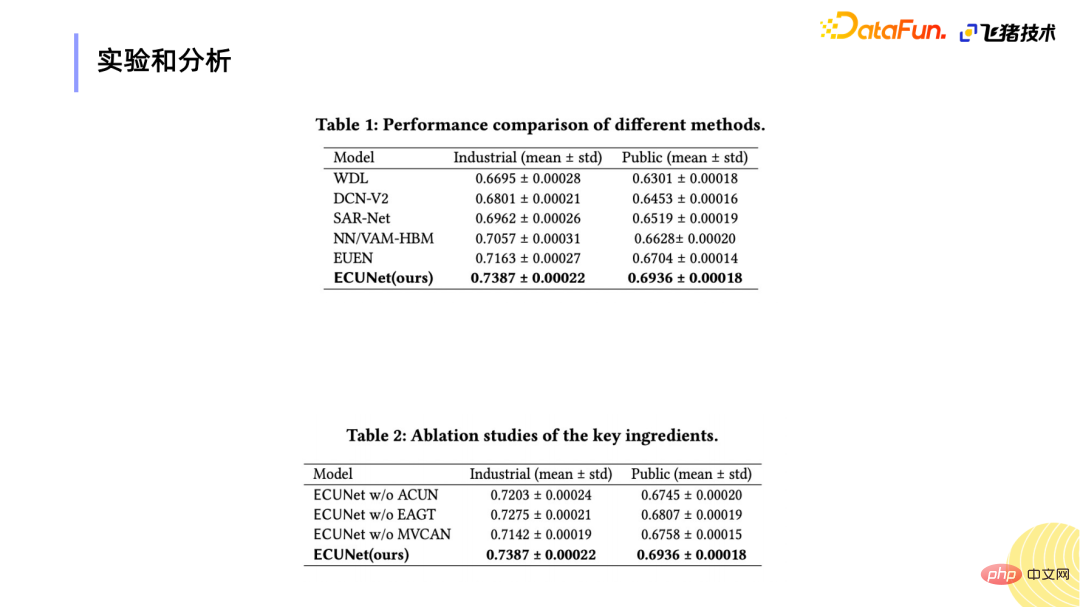
It can be seen from the experimental data that after the design of our network structure, there has been a certain improvement in AUC. Among them, the improvement of multi-view networks is more obvious, followed by gain networks, and then the structure of heterogeneous graph networks.
We have also collected some cases online and can learn some things about users’ scenarios. For example, weather information or long and short pictures and other scenes.
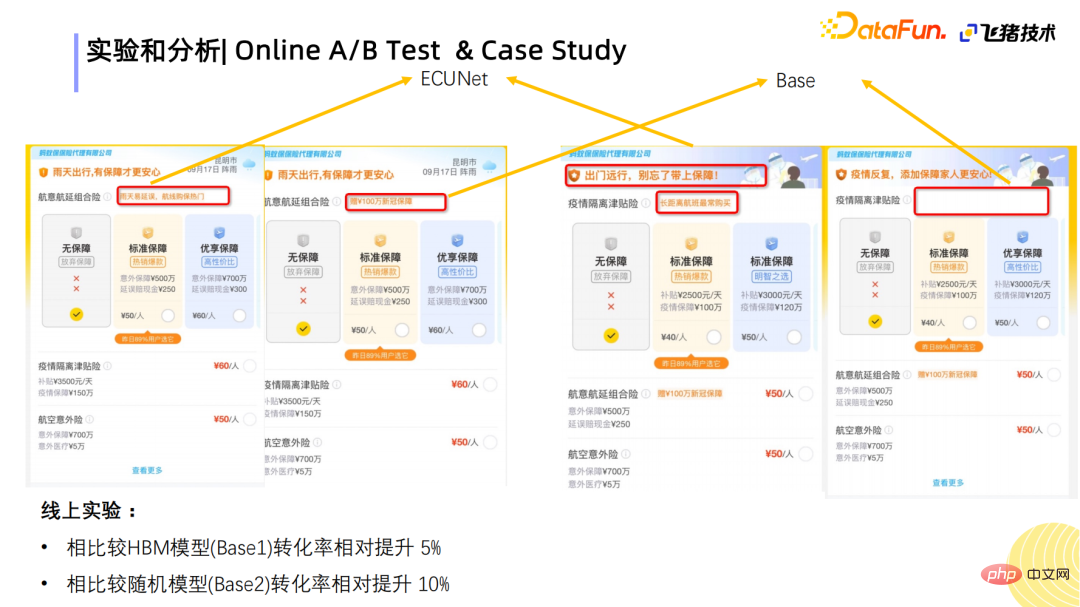
We have also done some experiments online. Compared with the Base2 random model, the improvement Compared with the advertising creative HPM model just mentioned, it has increased by 10%. ##5. Summary and Outlook
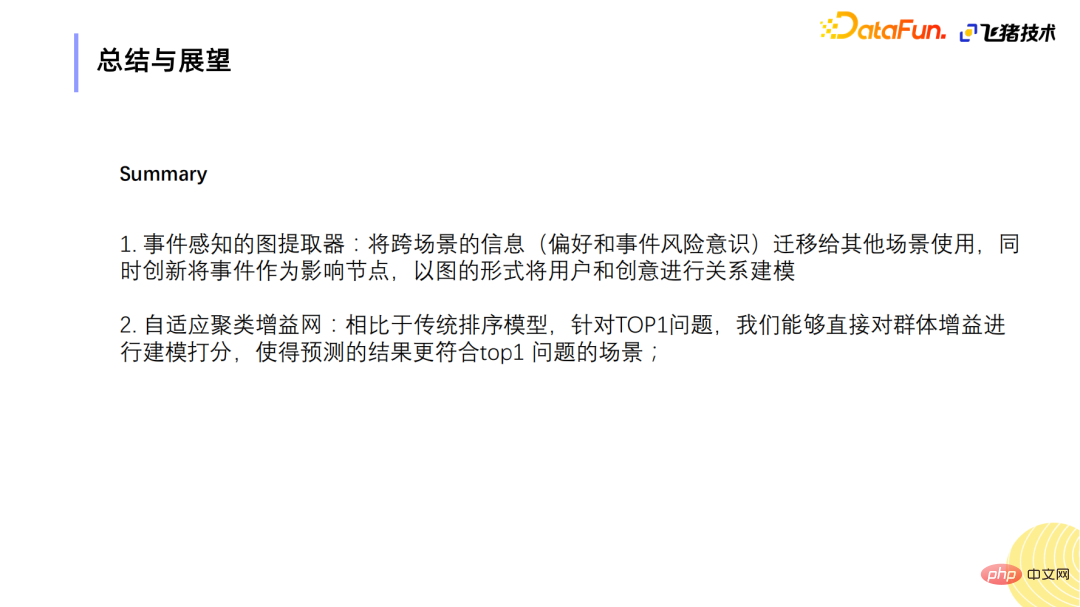
Event-aware graph extractor:
Currently in the industry There is less consideration for event perception, especially in the creative recommendation module. Our work is relatively innovative. By integrating some cross-scenario information, such as user preferences for certain insurance types, certain graphics and texts, or the migration of events between cross-scenarios. At the same time, this event is used as an influence node to model the relationship between users and creativity in the form of a graph. Adaptive clustering gain network:
Compared with traditional ranking problems, creative recommendation is a Top1 The problem is faced with some counterfactual phenomena encountered in causal inference. We can also better alleviate it through group gain learning. 6. Question and Answer Session
#Q1: How to achieve event understanding and scene understanding?
#A1: Event understanding mainly involves cooperation with operations. We will dig into the data. Events are sometimes unpredictable. If it is predictable, it can be precipitated into a label system. If it is unpredictable, we need to do some anomaly detection to dig out.
Scenario understanding, for example, in the search scenario, you can use some intentions in Query to analyze what the user wants to buy this time, but in insurance recommendations It is difficult to obtain what insurance the user wants to buy from the contextual information. Therefore, scenario understanding is more through reasoning. First, it is a data analysis insight, and then through some features. Above, we can see which scenarios have a transformation effect on users purchasing insurance or users purchasing ideas, and then integrate them into tags. In the system, we mainly do some things on the labeling side.
#Q2: What form of embedding does the creative copywriter do first?
#A2: It is mainly done in the form of recommendations. Multimodality is not reflected in this work. We have some work in other works. Embedding has just been mentioned, mainly for example, some ID-type representations, or some statistical representations, and then these representations will be in this graph network, and finally Embedding of a graph node will be carried out. One benefit of graph node embedding is that, for example, if a certain type of user is sensitive to some creative copywriting, there may be a similar thing between the user and the creative copywriting.
A3: Regarding edges, we mainly do a process similar to conditional transformation probability. For example, the conversion rate of a student node may be higher under bad weather conditions. In some cases, edge cropping operations will be performed. Edge representation learning is not involved, this is mainly in the learning process of nodes. A4: Event copywriting is still a bit manual. Because there have been many incidents in the insurance industry this year, we will also take a look at the impact period of each incident. The approximate cycle will be about one week to two weeks, so the time cycle of this area will also be controlled within this range. # Regarding the timeliness of copywriting, let’s bind the copywriting into a strong rule. For example, the Mid-Autumn Festival just passed some time ago. If we have Mid-Autumn Festival copywriting, then this copywriting will only take effect during the Mid-Autumn Festival. For example, if your departure time is during the Mid-Autumn Festival, or if your purchase time is during the Mid-Autumn Festival, it will be recalled, and it will definitely not be recalled at other times. That’s it for today’s sharing, thank you all. Q3: Is there any special treatment for edges in heterogeneous graph networks? Are different types of edges distinguished? Does the learning process involve representation learning and processing of edges?
#Q4: How timely is the event copywriting?
The above is the detailed content of Application of event-aware clustering gain network in creative ranking of Fliggy Insurance. For more information, please follow other related articles on the PHP Chinese website!

Hot AI Tools

Undresser.AI Undress
AI-powered app for creating realistic nude photos

AI Clothes Remover
Online AI tool for removing clothes from photos.

Undress AI Tool
Undress images for free

Clothoff.io
AI clothes remover

Video Face Swap
Swap faces in any video effortlessly with our completely free AI face swap tool!

Hot Article

Hot Tools

Notepad++7.3.1
Easy-to-use and free code editor

SublimeText3 Chinese version
Chinese version, very easy to use

Zend Studio 13.0.1
Powerful PHP integrated development environment

Dreamweaver CS6
Visual web development tools

SublimeText3 Mac version
God-level code editing software (SublimeText3)

Hot Topics
 CLIP-BEVFormer: Explicitly supervise the BEVFormer structure to improve long-tail detection performance
Mar 26, 2024 pm 12:41 PM
CLIP-BEVFormer: Explicitly supervise the BEVFormer structure to improve long-tail detection performance
Mar 26, 2024 pm 12:41 PM
Written above & the author’s personal understanding: At present, in the entire autonomous driving system, the perception module plays a vital role. The autonomous vehicle driving on the road can only obtain accurate perception results through the perception module. The downstream regulation and control module in the autonomous driving system makes timely and correct judgments and behavioral decisions. Currently, cars with autonomous driving functions are usually equipped with a variety of data information sensors including surround-view camera sensors, lidar sensors, and millimeter-wave radar sensors to collect information in different modalities to achieve accurate perception tasks. The BEV perception algorithm based on pure vision is favored by the industry because of its low hardware cost and easy deployment, and its output results can be easily applied to various downstream tasks.
 Implementing Machine Learning Algorithms in C++: Common Challenges and Solutions
Jun 03, 2024 pm 01:25 PM
Implementing Machine Learning Algorithms in C++: Common Challenges and Solutions
Jun 03, 2024 pm 01:25 PM
Common challenges faced by machine learning algorithms in C++ include memory management, multi-threading, performance optimization, and maintainability. Solutions include using smart pointers, modern threading libraries, SIMD instructions and third-party libraries, as well as following coding style guidelines and using automation tools. Practical cases show how to use the Eigen library to implement linear regression algorithms, effectively manage memory and use high-performance matrix operations.
 Explore the underlying principles and algorithm selection of the C++sort function
Apr 02, 2024 pm 05:36 PM
Explore the underlying principles and algorithm selection of the C++sort function
Apr 02, 2024 pm 05:36 PM
The bottom layer of the C++sort function uses merge sort, its complexity is O(nlogn), and provides different sorting algorithm choices, including quick sort, heap sort and stable sort.
 Can artificial intelligence predict crime? Explore CrimeGPT's capabilities
Mar 22, 2024 pm 10:10 PM
Can artificial intelligence predict crime? Explore CrimeGPT's capabilities
Mar 22, 2024 pm 10:10 PM
The convergence of artificial intelligence (AI) and law enforcement opens up new possibilities for crime prevention and detection. The predictive capabilities of artificial intelligence are widely used in systems such as CrimeGPT (Crime Prediction Technology) to predict criminal activities. This article explores the potential of artificial intelligence in crime prediction, its current applications, the challenges it faces, and the possible ethical implications of the technology. Artificial Intelligence and Crime Prediction: The Basics CrimeGPT uses machine learning algorithms to analyze large data sets, identifying patterns that can predict where and when crimes are likely to occur. These data sets include historical crime statistics, demographic information, economic indicators, weather patterns, and more. By identifying trends that human analysts might miss, artificial intelligence can empower law enforcement agencies
 Improved detection algorithm: for target detection in high-resolution optical remote sensing images
Jun 06, 2024 pm 12:33 PM
Improved detection algorithm: for target detection in high-resolution optical remote sensing images
Jun 06, 2024 pm 12:33 PM
01 Outlook Summary Currently, it is difficult to achieve an appropriate balance between detection efficiency and detection results. We have developed an enhanced YOLOv5 algorithm for target detection in high-resolution optical remote sensing images, using multi-layer feature pyramids, multi-detection head strategies and hybrid attention modules to improve the effect of the target detection network in optical remote sensing images. According to the SIMD data set, the mAP of the new algorithm is 2.2% better than YOLOv5 and 8.48% better than YOLOX, achieving a better balance between detection results and speed. 02 Background & Motivation With the rapid development of remote sensing technology, high-resolution optical remote sensing images have been used to describe many objects on the earth’s surface, including aircraft, cars, buildings, etc. Object detection in the interpretation of remote sensing images
 Practice and reflections on Jiuzhang Yunji DataCanvas multi-modal large model platform
Oct 20, 2023 am 08:45 AM
Practice and reflections on Jiuzhang Yunji DataCanvas multi-modal large model platform
Oct 20, 2023 am 08:45 AM
1. The historical development of multi-modal large models. The photo above is the first artificial intelligence workshop held at Dartmouth College in the United States in 1956. This conference is also considered to have kicked off the development of artificial intelligence. Participants Mainly the pioneers of symbolic logic (except for the neurobiologist Peter Milner in the middle of the front row). However, this symbolic logic theory could not be realized for a long time, and even ushered in the first AI winter in the 1980s and 1990s. It was not until the recent implementation of large language models that we discovered that neural networks really carry this logical thinking. The work of neurobiologist Peter Milner inspired the subsequent development of artificial neural networks, and it was for this reason that he was invited to participate in this project.
 Application of algorithms in the construction of 58 portrait platform
May 09, 2024 am 09:01 AM
Application of algorithms in the construction of 58 portrait platform
May 09, 2024 am 09:01 AM
1. Background of the Construction of 58 Portraits Platform First of all, I would like to share with you the background of the construction of the 58 Portrait Platform. 1. The traditional thinking of the traditional profiling platform is no longer enough. Building a user profiling platform relies on data warehouse modeling capabilities to integrate data from multiple business lines to build accurate user portraits; it also requires data mining to understand user behavior, interests and needs, and provide algorithms. side capabilities; finally, it also needs to have data platform capabilities to efficiently store, query and share user profile data and provide profile services. The main difference between a self-built business profiling platform and a middle-office profiling platform is that the self-built profiling platform serves a single business line and can be customized on demand; the mid-office platform serves multiple business lines, has complex modeling, and provides more general capabilities. 2.58 User portraits of the background of Zhongtai portrait construction
 Add SOTA in real time and skyrocket! FastOcc: Faster inference and deployment-friendly Occ algorithm is here!
Mar 14, 2024 pm 11:50 PM
Add SOTA in real time and skyrocket! FastOcc: Faster inference and deployment-friendly Occ algorithm is here!
Mar 14, 2024 pm 11:50 PM
Written above & The author’s personal understanding is that in the autonomous driving system, the perception task is a crucial component of the entire autonomous driving system. The main goal of the perception task is to enable autonomous vehicles to understand and perceive surrounding environmental elements, such as vehicles driving on the road, pedestrians on the roadside, obstacles encountered during driving, traffic signs on the road, etc., thereby helping downstream modules Make correct and reasonable decisions and actions. A vehicle with self-driving capabilities is usually equipped with different types of information collection sensors, such as surround-view camera sensors, lidar sensors, millimeter-wave radar sensors, etc., to ensure that the self-driving vehicle can accurately perceive and understand surrounding environment elements. , enabling autonomous vehicles to make correct decisions during autonomous driving. Head





